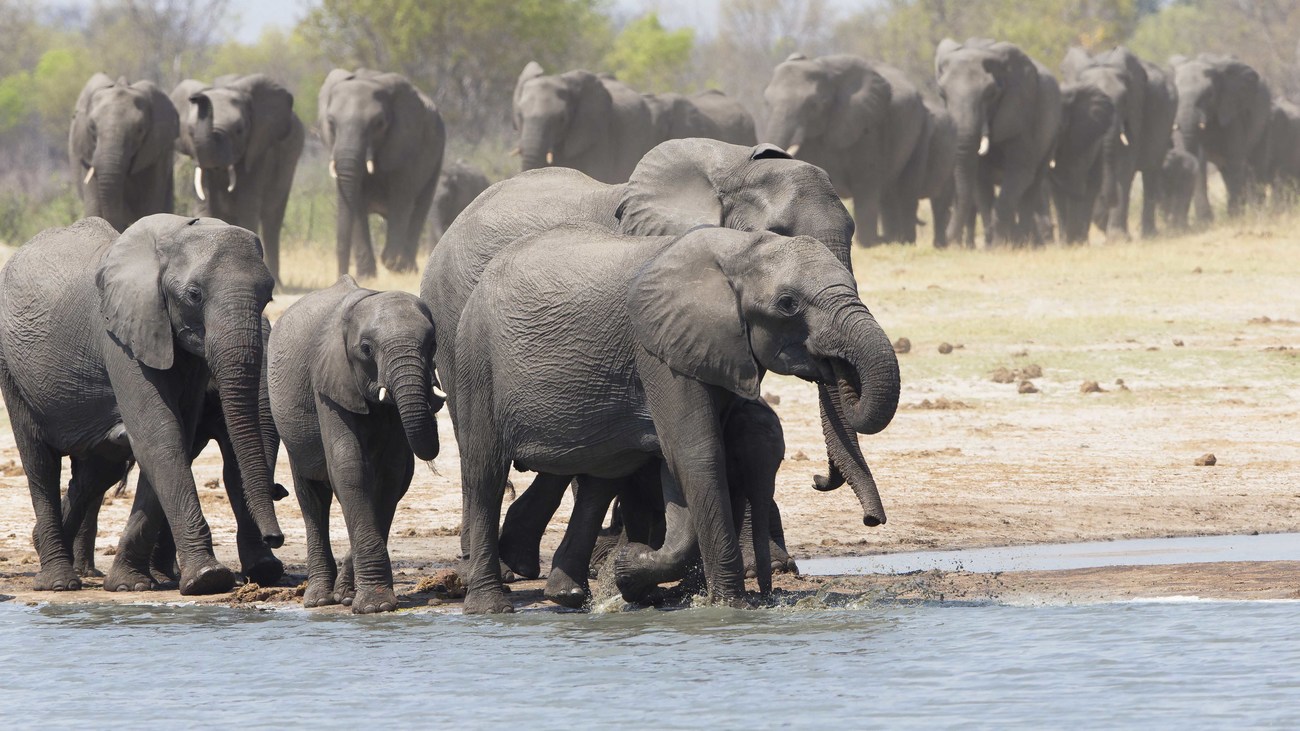Azzedine Downes
I have never been satisfied with just fighting the good fight. We need to actually make a difference.
ifaw-ZimParks partnership make strides for conservation at Hwange National Park

It has been 18 months since the International Fund for Animal Welfare (IFAW) and Zimbabwe Parks and Wildlife Management Authority (ZimParks) met at their Harare HQ to shake hands on the signing of a Conservation Partnership Memorandum of Understanding (MOU) where over USD 4 million is expected to be channeled towards conservation support. In this blog IFAW CEO and President, Azzedine Downes, and Dr. Fulton Mangwanya, Director General of ZimParks, explain how the partnership has played a key role in the protection and conservation of Zimbabwe’s iconic natural resources.
The MOU between ZimParks and IFAW focuses on the protected area of the Hwange-Matetsi-Zambezi ecosystem in the North-Western part of Zimbabwe. At 14,600 kilometres² (5,627 miles²), Hwange National Park is Zimbabwe’s largest protected area and arguably among the largest parks on the African continent, home to 150 species of mammals, 400 bird Species (Important Bird Area), and approximately 45,000 elephants (National Elephant Survey Report, 2014). The ZimParks–IFAW partnership fosters financial support and technical expertise in the management of these protected areas. The major objective is to protect biodiversity, conserve ecological processes, and promote human livelihoods and well-being in the approximately four million-acre landscape that is a key anchor to the Kavango-Zambezi Trans-Frontier Conservation Area (KAZA-TFCA).
Phase 1 of IFAW support for ZimParks in Hwange National Park largely focuses on the isolated 4,500 km² Makona southern subsector of the park, where rangers manage a 160 km border shared with community lands as well as an extensive section of about 100km of the shared border with Botswana. Since the inception of the project, IFAW has invested more than US $1 million in Hwange National Park towards infrastructure development, ranger training, tools and equipment, game water supply, capacitation of the Veterinary Unit, and operational support.
When the COVID-19 pandemic hit, all tourism activities halted. Wildlife rangers were classified as emergency services and had to stay in their positions for months. Without the added activity of tourists, the daily comings and goings within the park, and the harsh economic impact, we had shared concerns that poaching would spiral upwards. In May 2020 rangers embarked on 1,222 extended patrols – over 200 more than planned for the month, and nearly 500 more than in May 2019. This momentum has continued throughout the year largely due to IFAW’s support, which has provided two new patrol vehicles, refurbished two old vehicles, and provided adequate additional fuel to enable patrols to travel deeper into remote sections of the park. Incredibly, a record of not even a single elephant was poached in the Main Camp, Sinamatella and Robin’s Camp areas of Hwange National park during 2020!
One of the first achievements of the partnership was the rehabilitation of a key artery in Hwange, the 90km road linking Makona and Hwange Main Camp. Shortly before Covid19 lockdown hit, IFAW’s support had enabled the road to be graveled. This cut travel time from the Makona substation (ranger camp) by half; what used to take 3.5 hours to reach now takes about 90 minutes. The rehabilitated road has also now enabled tourists to visit areas that were previously inaccessible by non-four wheel drive vehicles.
Phase 1 of our ambitious plan to invest in conservation infrastructure includes the construction of four new houses for rangers, a recreational facility, an operations center and three ranger field bases. Renovations will benefit the 56 rangers and their families who will live and work in Makona. Pleasingly, 44 community youths, have been employed for the construction work – earning approximately US $10,000 by the completion of Phase 1. We are almost finished with the installation of a landscape-wide VHF radio network to improve response to incidents of poaching.
The IFAW-ZimParks partnership recently tackled the long-standing water management problem at Hwange National Park. Nyamandhlovu Pan, a critical waterhole for wildlife and key tourist attraction, hadn’t been scooped in about 20 years. With IFAW’s help, the water volume capacity of the Pan has increased by the equivalent of about five Olympic sized swimming pools and the good seasonal rains have filled it to capacity.
Other areas of work supported by the partnership include equipping Hwange National Park’s workshop at the Main Camp with the tools required to maintain the 69 vehicles it services across the Hwange Cluster and refresher training for its artisans. In addition, the Veterinary Field Laboratory has received new equipment and drug supplies, improving veterinary support for Hwange National Park’s dog unit and wildlife rescue efforts in the landscape.
The conservation need is compelling and requires bold and fresh approaches. IFAW is committed to long term financial and technical investment across multifaceted bold and tangible projects to enhance conservation development in the landscape.
When we look back where we started, our partnership was received with suspicion by certain constituencies that are not familiar with IFAW as one of the strategic allies for wildlife conservation in southern Africa. As a matter of fact, IFAW has been supporting various conservation initiatives in the region for some time.
- Azzedine Downes, IFAW President and CEO & Dr. Fulton U. Mangwanya, Director-General of Zimbabwe Parks and Wildlife Management Authority (ZimParks)
Azzedine Downes
I have never been satisfied with just fighting the good fight. We need to actually make a difference.
every problem has a solution, every solution needs support.
The problems we face are urgent, complicated, and resistant to change. Real solutions demand creativity, hard work, and involvement from people like you.
Unfortunately, the browser you use is outdated and does not allow you to display the site correctly. Please install any of the modern browsers, for example:
Google Chrome Firefox Safari